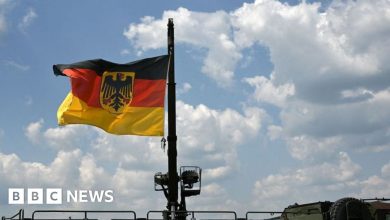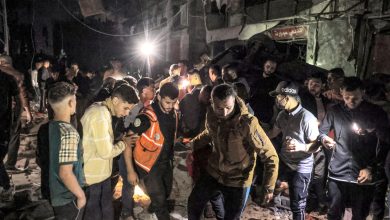‘Putin is vindictive’: Russia strikes Ukraine as kyiv continues assault on Kursk | Russia-Ukraine War

Kyiv, Ukraine – Russia’s air attack on Ukraine was colossal.
Moving in waves from several directions and at different speeds and heights, 127 missiles and 109 drones attacked 15 of Ukraine’s 24 regions.
The attack is seen in Ukraine as revenge by Russian President Vladimir Putin for kyiv’s audacious incursion into Russia’s western Kursk region, which began in early August and resulted in the apparent takeover of more than 1,000 square kilometers (386 square miles).
“He is a vindictive person, he felt offended,” Lieutenant General Ihor Romanenko, former deputy chief of the General Staff of the Ukrainian Armed Forces, told Al Jazeera.
The attack began in the pre-dawn darkness on Monday, as swarms of heavy drones laden with explosives took off from the city of Yeisk on the Sea of Azov in southwestern Russia.
Then the Kinzhal (Dagger) ballistic missiles took off from under the wings of MiG 31 fighter jets stationed in the city of Lipetsk in western Russia.
The Kinzhals can maneuver in flight and reach a breathtaking speed of 4 km per second, half the speed a rocket needs to reach space.
Tu-95 heavy bombers in the Volgograd region launched Kh-101 missiles, the same type that struck Ukraine’s largest children’s hospital in July.
Despite their subsonic speed, the Kh-101s are difficult to intercept as they can only fly 50 meters (164 feet) above the ground and zigzag on their way to their targets.
Iskander ballistic missiles were fired from the western Voronezh region and annexed Crimea.
“This attack was bigger than usual”
The wail of air raid sirens woke Anatoly Dmitruk, a railway maintenance worker, despite the wax earplugs he stuffs into his ears every night.
But he fell asleep “a few times” before air defense systems filled the air with deafening roars as they shot down missiles and drones.
“I realised that this attack was bigger than usual,” Dmitruk told Al Jazeera.
He checked the Telegram channel Radar Ukraine to see the scale of the attack — and got out of bed to sit in the hallway, following the “be between two walls” rule he learned when Russia’s full-scale invasion began in 2022.
That’s when his wife and 17-year-old son Arseniy left Ukraine, first for the former Soviet Republic of Moldova and then for the western German city of Düsseldorf.

The explosions stopped before 8 a.m. The air raid alert was maintained for three hours.
For Dmitruk, the unprecedented length of the alert held a glimmer of hope.
The portly 39-year-old lives in a two-bedroom apartment in eastern kyiv, and his only way to get to work is by subway, which spans the 700-meter (2,297-foot) metro bridge over the Dnieper River and stops running when there is an alert.
“So I went back to bed and had a lovely morning at home,” Dmitruk said.
Asked if he was afraid, he shrugged with an indifferent “meh.” Putin, he added, had gone “crazy.”
Feelings of anxiety have eased after hundreds of air raid warnings in kyiv since 2022, a Ukrainian psychologist has said.
“Anxiety about the upcoming bombings is a common emotional background for millions of Ukrainians,” Svitlana Chunikhina, vice-president of the Association of Political Psychologists, a Kiev group, told Al Jazeera.
On the one hand, they adapted to the threats and routinized their security practices by hiding in a shelter, between two walls or in a subway station, she said.
But on the other hand, stress builds up, becomes chronic, and its destructive consequences can manifest themselves years later, she said.
However, Moscow’s airstrikes have not achieved their main goal, namely to “reach the threshold” of patience of the Ukrainian public and politicians, she said.
“This does not happen, and this is the main effect of massive missile attacks on Ukrainian cities,” she concluded.
“Russia’s most massive attack”
Ukrainian air defense forces shot down 102 out of 127 missiles and 99 out of 109 drones, Air Force Commander Mykola Oleshchuk said.
“It was the most massive attack by Russia,” he said.
However, the rest of the missiles and drones hit 15 of Ukraine’s 24 regions, killing seven people, injuring 47 and damaging buildings, power plants and transmission stations, rescue officials said.
Russia has consistently denied targeting civilians and said its “high-precision strike” hit Ukraine’s energy infrastructure that “supports the military-industrial complex.”
The attack hit the 288-meter-long (945-foot) dam that is part of the Kiev hydroelectric power station, a few kilometers upstream from the capital.
But the damage is insignificant and the dam is “intact,” said Tymofei Mylovanov, an adviser to Ukrainian President Volodymyr Zelenskyy.
“If the dam had collapsed, a significant part of kyiv would have been flooded,” he said.
Completed in 1968, the dam ended the annual spring floods that reached parts of kyiv, particularly its lower left bank.
The dam was redeveloped in 2011, but many residents on the left bank are worried.
If the dam is destroyed, the resulting flood “will wash away our house in five minutes,” Tetyana Kravchenko, who lives in a two-story house she and her husband completed in 2019, told Al Jazeera.
The house is just 100 metres from a sandy beach on the Dnieper River – a luxury that turned into a disadvantage during the war, she said.
“We thought there would be peace and quiet, but instead we feel like we are living next to an abyss,” said the 52-year-old cafe owner.
Hours after the attack, power outages began across kyiv, after weeks of relatively stable electricity supply.
And while the direct damage from the attack may not be significant, the indirect losses are much higher, according to a kyiv-based analyst.
“These are factors that drive migration, that lead to the closure of factories, that create a general negative context, etc.,” Aleksey Kushch told Al Jazeera.
“Indirect losses are enormous, they are several times greater than direct losses.”
Meanwhile, Ukraine is responding to Russia’s airstrikes in almost the same way.
Dozens of Ukrainian drones have been shot down over western Russia this week alone, including eight flying towards Moscow, according to media reports.
A heavy drone was shot down on Wednesday near the Olenya military airbase that houses Tu-22M3 heavy bombers in Russia’s Murmansk region, about 1,800 km from the Ukrainian border.
Even if the attack failed, its distance leaves about 2.6 million square kilometers (10 million square miles) of western Russia – an area the size of Argentina – vulnerable to Ukrainian heavy drones, the online magazine Verstka calculated.





